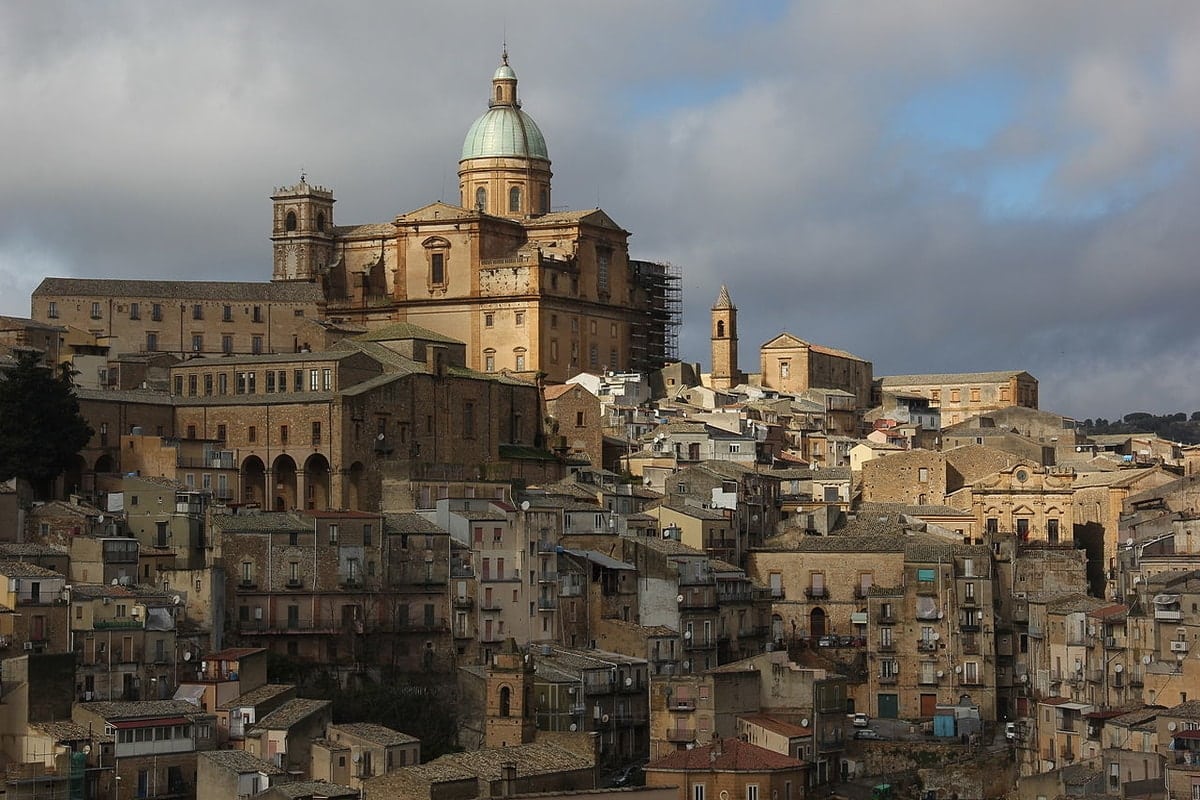


As you seek respite from the whirlwind pace of modern life, imagine a place where the threads of medieval history can weave an enchanting tapestry that transports you to another era. You’re yearning for a cultural adventure, one that marries the elegance of ancient artistry with the tranquil beauty of medieval charm.
| Embrace the allure of Sicilian landscapes with our rent a villa in Sicily options, where every view is a masterpiece. |
Nestled in the heartland of Sicily lies Piazza Armerina, a gem waiting to be discovered by those who thirst for culture and luxury.
This town is more than just a dot on the map; it’s home to the Villa Romana del Casale, boasting some of the most exquisite Roman mosaics globally – an enduring testament to the town of imperial grandeur and UNESCO World Heritage Site status.
As our guide unfolds before you, each paragraph will open doors to majestic pasts: lush tales embroidered in threads of gold, stone chapels echoing choral hymns through time-warped alleyways.
Indulge yourself in this journey through Piazza Armerina as we unveil its regal splendor and timeless allure.
Your quest for serenity amidst opulent history begins now.
Nestled amidst the verdant hills of central Sicily, Piazza Armerina emerges as a tapestry woven from threads of ancient Rome and medieval grandeur. Here, history’s embrace is palpable, whispering tales of bygone splendor through its cobbled streets and architectural wonders.
Piazza Armerina, a jewel in central Sicily, basks in its strategic position at the Mediterranean’s heart. Its land is a tapestry of history and geology, where scientific explorations beneath the soil bolster tales from ancient Rome.
The town stands proud as a testament to cultural heritage, inviting those with a penchant for discovery to visit, roam and walk its storied streets.
Within the Casale district lies an archaeological wonder: the Roman Villa, famed for its intricate mosaics and scholarly significance in late Roman studies. Visitors here are transported through time as they step over thresholds once crossed by historical figures whose legacies echo through centuries.
Piazza Armerina not only offers a glimpse into yesteryear but also serves as an axis upon which past and present converge amidst baroque architecture and medieval echoes.
The tapestry of Piazza Armerina is woven with threads that date back to medieval times. Majestic cathedrals stand as monuments to a bygone era, where the influence of Norman conquerors left an indelible mark on the town’s architecture and cultural fabric.
Echoes of jousting knights reverberate annually during the Palio dei Normanni, a vibrant festival that commemorates this town’ storied past.
Venture deeper into history, and one discovers the Roman villa in the Casale district—a remarkable archaeological treasure trove showcasing opulent mosaics that paint vivid pictures of ancient luxury and leisure.
This iconic site stands as a testament to late Roman artistry, drawing scholars and aesthetes alike to its hallowed hallways. The splendor captured in these centuries-old scenes contributes richly to understanding Piazza Armerina’s grand historical narrative.
Step into Piazza Armerina, where the past’s splendor emerges through the cobbled streets and architecture. Here, every corner whispers tales of antiquity, beckoning you to behold treasures such as Villa Romana di Casale’s intricate mosaics and the ecclesiastical marvels that adorn this historic tapestry.
The Roman Mosaics of Villa Romana di Casale stand as a testament to the opulence and grandeur of ancient artistic expression. Nestled about 5km from Piazza Armerina, this archaeological marvel is steeped in richness and quality.
Each mosaic piece tells a story, weaving intricate tales that celebrate the dominus with both directness and allegory. The vast complex spans across an impressive 3,500 square meters, showcasing the largest collection of late Roman mosaics in all their vibrant hues and meticulous details.
Visitors are captivated by scenes of mythical creatures and daily life etched into stone over centuries ago. These exceptional artworks not only exhibit supreme craftsmanship but also reflect cultural narratives integral to that historic era.
As you step on tiled floors decorated with elaborate designs, a sense of stepping back in time washes over you—an immersive encounter with history exclusive to Villa Romana del Casale’s majestic confines.
Piazza Armerina boasts a remarkable collection of spiritual edifices, each echoing the city’s deep-rooted faith and artistic legacy. With ten churches and cathedrals adorning its streets, the city is often referred to as ‘the city of a hundred churches‘.
Stroll through this ecclesiastical tapestry where every corner unfurls centuries-old stones cradling tales of devotion. Marvel at Chiesa di San Pietro’s majestic presence while exploring medieval architecture that has stood the test of time.
Delving further into this sacred landscape reveals intricate frescoes by Guglielmo Borremans inside S. Maria dell’Ammiraglio, an ancient church showcasing Gothic architecture that rivets both believers and admirers alike.
Amidst palazzo trigona’s grandeur and archaeological whispers from ancient sites, these hallowed structures remain not only places of worship but also custodians of history and artistry inextricably woven into Piazza Armerina’s identity.
Moving beyond these silent storytellers draws one closer to yet another facet of Piazza Armerina – its vibrant cultural highlights beckoning with promises of rich experiences ahead.
Piazza Armerina dazzles with an array of cultural festivities that celebrate the town’s rich heritage. Art lovers converge here to wander through the ancient streets, discovering hidden gems like the former Church of of San Giovanni Evangelista, which boasts intricate frescoes and architectural nuances reflective of Borromini’s influence.
Each corner turned offers a new spectacle, from vibrant murals adorning aged buildings main landmarks in historic centre to impromptu musical performances echoing off the stone.
The scent of traditional Sicilian cuisine wafts through the piazzas as ristorantes serve up delicacies that are both a feast for the palate and a nod to Caltanissetta’s culinary legacy.
Visitors immerse themselves in local customs during lively annual festivals that transform Piazza Armerina into a mosaic of music, dance, and historical reenactments. As night falls, lights illuminate archaeological sites casting an ethereal glow on this timeless landscape; thus paving the way towards “Conclusion”, where we delve into how these experiences leave indelible impressions on those who venture into this captivating corner of Sicily.
In the heart of Sicily lies a jewel steeped in history and elegance: Piazza Armerina. Here, cultural treasures merge with architectural marvels to craft an unforgettable tapestry of heritage.
Every cobblestone whispers tales from antiquity, inviting wanderers to traverse through epochs. As sunlight dances on ancient mosaics, the town beckons connoisseurs of culture to bask in its timeless splendor.
Embrace this regal haven where every visit enriches the soul with a touch of bygone luxury.
Piazza Armerina, nestled in the heart of Sicily, is a tapestry of historical splendor and culture. Its mosaic-adorned cathedrals echo tales from bygone eras, inviting visitors to step into a world where history breathes through ancient stones.
Indeed, one can journey through the digital pages of Wikipedia to uncover the rich narrative of Piazza Armerina. Each scroll reveals layers of its storied past, from majestic cathedrals to historic battles that shaped its present.
Beholding the grandeur of Piazza Armerina is an encounter with living history; it’s an immersion into a cultural heritage that stands as testament to human artistry and devotion—a truly experiential odyssey for any traveler.
Yes, like threads in a magnificent tapestry, Piazza Armerina weaves connections to other historical marvels such as the Cathedrals of Cefalù—each site contributing uniquely to Italy’s rich pageantry of cultural treasures.
Piazza Armerina Cathedral, a jewel in the town’s historical tapestry, showcases magnificent, Baroque architecture and Cathedral architecture with impressive Catalan Gothic style windows and notable portals adorned with spiral columns, reflecting the grandeur of Piazza Armerina’s rich religious and architectural heritage.
Yes, visitors to Piazza Armerina can immerse themselves in the charm of its Historic Centre, a labyrinth of medieval streets dotted with significant architecture dating back centuries, including ancient churches and palazzos like Palazzo Trigona, and important medieval frescoes revealing the town’s vibrant past.
The Villa Romana del Casale in Piazza Armerina is famed for its stunning Roman mosaics, a UNESCO World Heritage site that offers a peek into luxurious Roman life, featuring well-preserved artistic mosaics that depict intricate scenes from ancient times.
Piazza Armerina in Sicily is home to a myriad of hidden gems, from the massive Baroque Cathedral to the ancient church of San Rocco, each adorned with religious art works and steeped in the medieval history of this autonomous island region.
At Piazza Armerina’s Diocesan Museum, visitors can explore a rich collection of other religious art works, including former church artifacts and paintings, each piece narrating the historical and spiritual journey of this significant town in Sicily.
Piazza Armerina is renowned for its diverse architectural styles, from the historic centre’s medieval history and Baroque influences to the Aragonese Castle and other significant architecture, each contributing to the town’s reputation as a historical centre and a cultural and historical hub in Sicily.